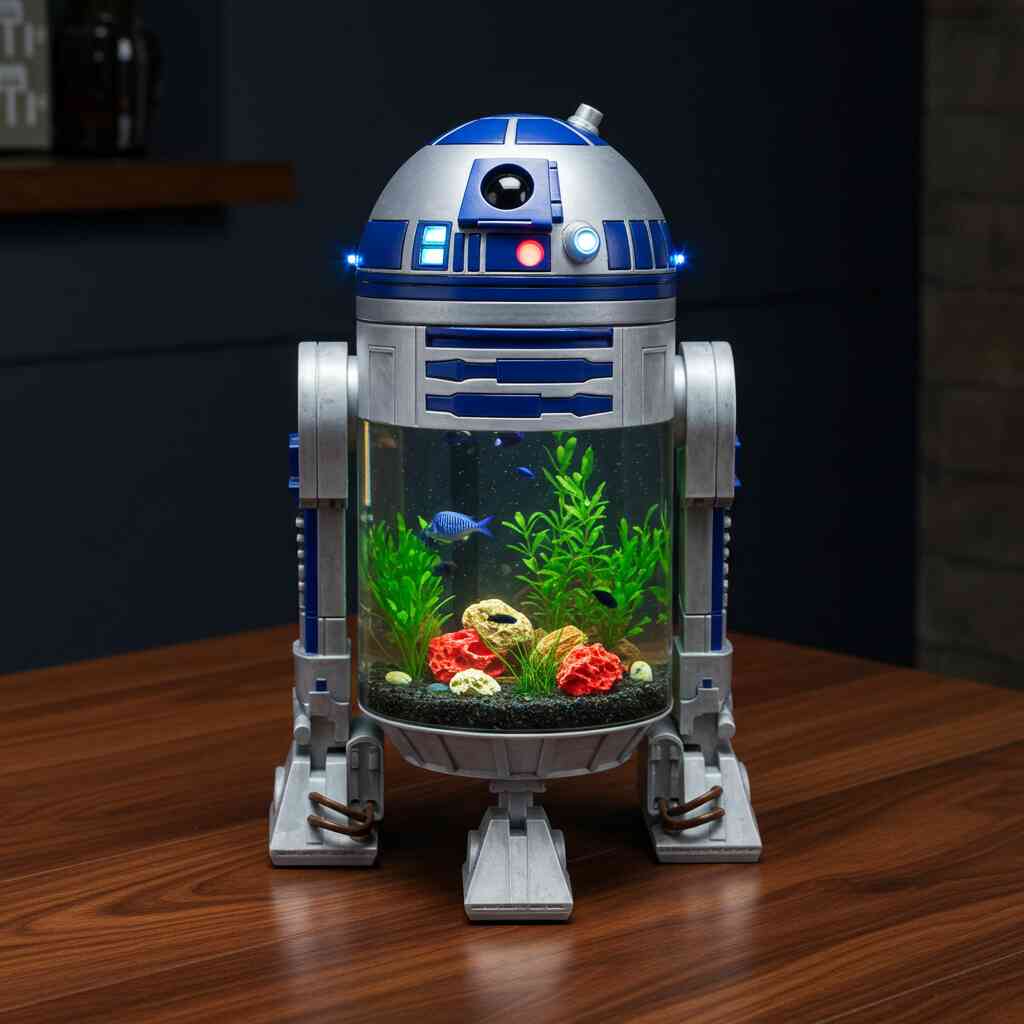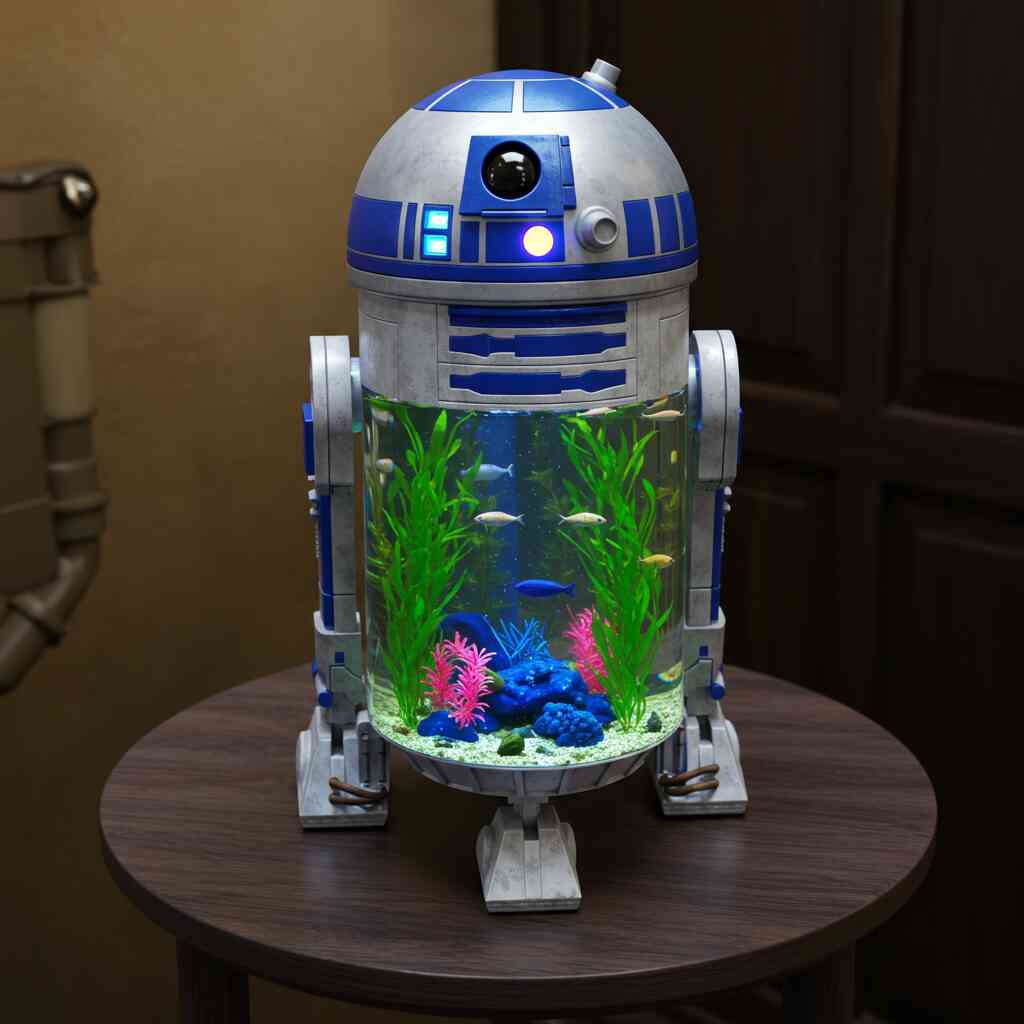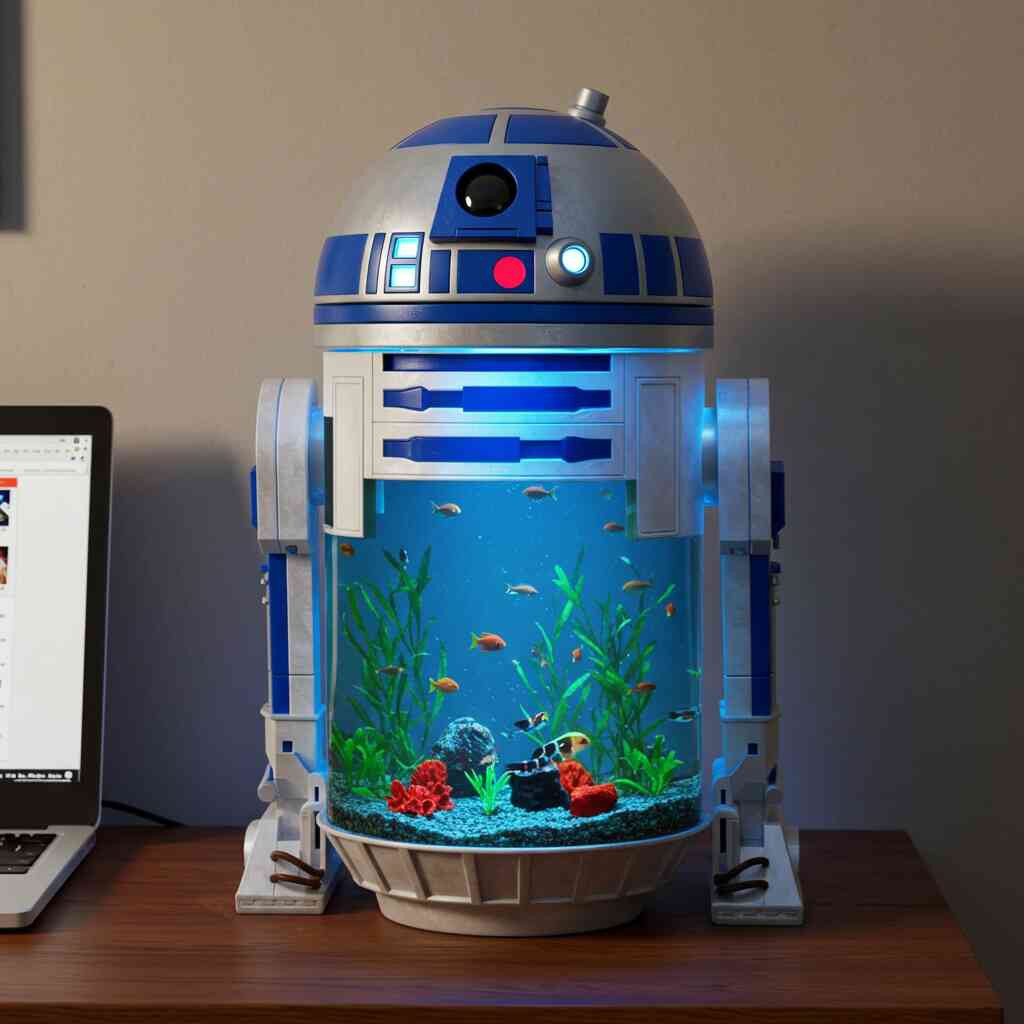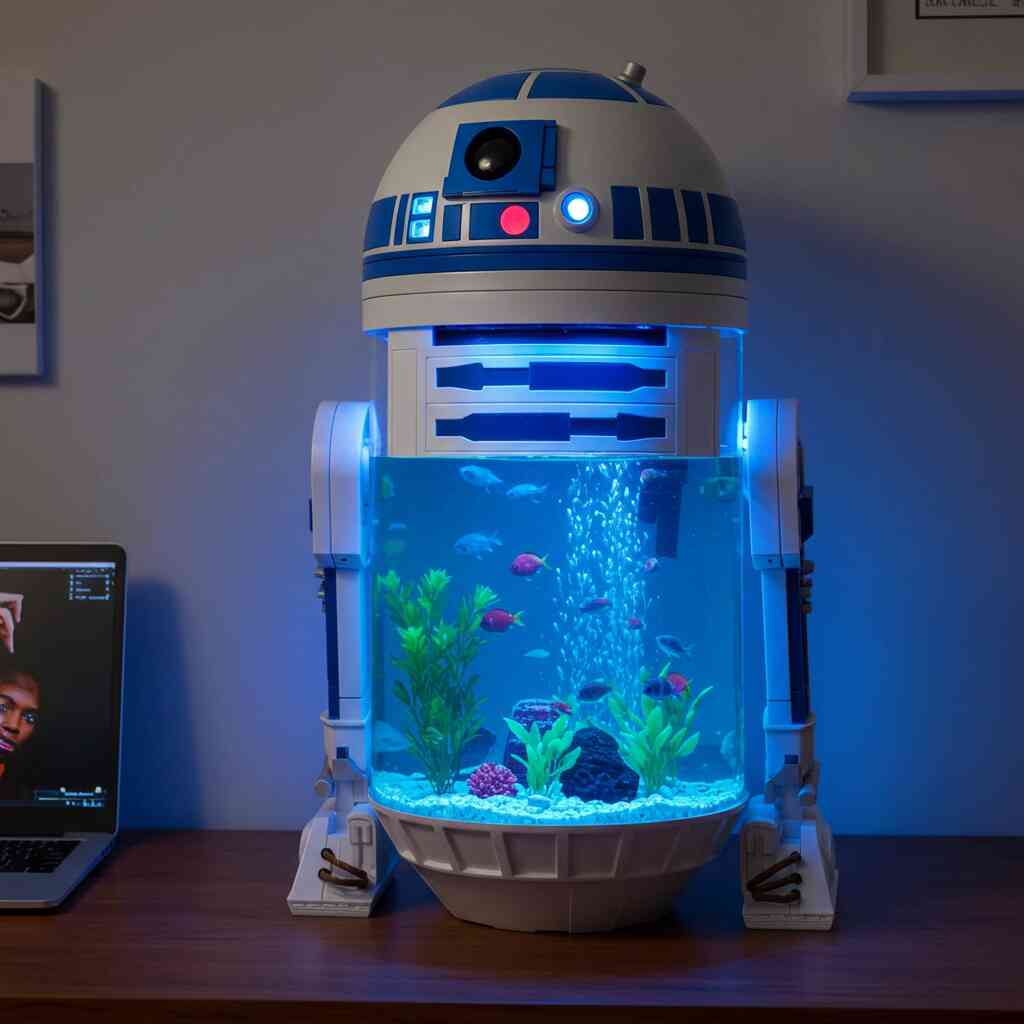For many fans, Star Wars is more than just a movie franchise—it’s a way of life. From lightsaber replicas to intricate LEGO builds, enthusiasts constantly seek ways to bring the galaxy far, far away into their homes. Among the most creative expressions of this passion are custom-built aquariums that merge science fiction aesthetics with aquatic life. One of the most iconic characters in the saga—R2-D2—has become an especially popular muse for DIY fish tank builders.
The idea of transforming a beloved droid into a functional fish tank may seem whimsical at first glance, but it’s a project that blends technical craftsmanship with artistic design. A Custom R2D2 Fish Tank isn’t just a quirky home decor item; it’s a testament to creativity, fandom, and the joy of making something truly unique. Whether you’re a seasoned aquarist or a casual fan with a knack for tinkering, building your own R2D2 fish tank can be a rewarding challenge that impresses both fellow Star Wars lovers and visitors alike.
This article delves deep into the world of DIY R2D2 fish tanks, exploring how to conceptualize, design, and construct a custom version tailored to your vision. We’ll walk through the planning process, material selection, assembly techniques, and personalization options, all while keeping the focus on the fun and fulfillment of creating something from scratch. So, if you’ve ever dreamed of watching your fish swim inside a fully functional replica of everyone’s favorite astromech droid, read on.

Part 1: Conceptualizing Your Custom R2D2 Fish Tank
Understanding the Vision Behind the Build
Before diving into tools and materials, the first step in any successful DIY project is visualization. What exactly do you want your Custom R2D2 Fish Tank to look like? While R2-D2’s general silhouette is unmistakable, there are countless variations in scale, color scheme, and detail that can influence your build. Some builders aim for hyper-realism, replicating every panel line and antenna fold with precision, while others take a more stylized approach, focusing on capturing the essence rather than exact duplication.
It’s important to decide early on whether your tank will be a full-scale replica (which could stand over four feet tall) or a smaller desktop version. Each comes with its own set of challenges and rewards. Full-scale models offer greater immersion and visual impact, but they also require more space, materials, and time. Desktop versions are more manageable for beginners and ideal for apartments or offices.
Additionally, consider the function of the tank itself. Will it house freshwater or saltwater fish? How much water volume do you need based on the type of fish you plan to keep? These questions directly affect the size and internal structure of your build and must be considered before construction begins.
Sketching and Design Planning
Once you have a rough idea of the size and style of your tank, sketching out detailed plans becomes essential. Many DIY builders start with hand-drawn blueprints or use digital tools like Tinkercad or SketchUp to create 3D models. This helps visualize how different components will fit together and allows for adjustments before cutting into expensive materials.
A key consideration during the design phase is how to integrate the fish tank within the R2D2 shell. Since R2-D2 is cylindrical in shape, the main body often serves as the central water chamber. However, some designs incorporate separate compartments for filtration, lighting, and even control panels that mimic the droid’s real-world functions.
Another important factor is accessibility. You’ll need to plan for areas where you can feed the fish, clean the tank, and maintain equipment without compromising the aesthetic integrity of the R2D2 model. Hatches, removable panels, and hidden compartments are commonly used solutions.

Part 2: Building the Framework – Materials and Assembly Techniques
Choosing the Right Materials
When it comes to constructing a Custom R2D2 Fish Tank , material selection is crucial—not only for structural integrity but also for waterproofing and safety. Acrylic is often the preferred choice for the transparent sections due to its clarity, strength, and ease of shaping compared to glass. For the outer shell and mechanical details, builders typically use lightweight yet durable materials such as:
- Foam board or EVA foam for sculpting curved surfaces
- PVC piping and connectors for structural support and detailing
- Plastic sheeting or fiberglass-reinforced plastic for durable outer shells
- Metal accents (optional) for advanced builds seeking a more industrial look
Each material has its pros and cons, and the choice depends largely on your skill level, budget, and desired finish. Beginners might opt for simpler materials like PVC pipes and foam, while experienced builders might venture into resin casting or CNC-cut panels for higher accuracy.
Constructing the Main Body
The core of your Custom R2D2 Fish Tank will likely be the cylindrical section that holds the water. This part needs to be watertight, so careful attention must be paid to seams and joints. If using acrylic sheets, these can be heat-formed into a cylinder and bonded together using solvent cement designed specifically for acrylic.
Some builders prefer to use pre-made acrylic tanks and then build the R2D2 exterior around them. This method simplifies the process by separating the functional tank from the decorative shell. However, integrating the two requires precise measurements and mounting techniques to ensure stability and alignment.
Once the main tank is constructed, the next step is building the outer shell that mimics R2D2’s iconic dome and base. This involves layering materials to achieve the correct curvature and depth. Foam is often carved and shaped to form the basic contours, which are then covered with smoother materials like plastic or painted resin for a polished look.

Adding Mechanical Details and Features
One of the most satisfying aspects of building a Custom R2D2 Fish Tank is recreating the intricate mechanical features that define the droid. These include:
- Dome rotation mechanism (for display purposes)
- Retractable arms or panels
- Antenna and sensor domes
- Panel lines and rivet details
- Lighting effects (LED strips for eyes and glowing sections)
While not all of these features need to be functional, incorporating motion or light can dramatically enhance the realism of your build. Simple electric motors can be used to rotate the dome slowly, and LED lights embedded behind translucent panels can simulate active sensors or glowing compartments.
Painting and weathering are also key elements in bringing your R2D2 to life. Use spray paints in the standard white, blue, and gray palette, and apply dry brushing or washes to highlight surface details. For added realism, consider distressing the paint slightly to give the impression of battle-worn service.
Sealing and Waterproofing
Since this is a functioning fish tank, ensuring everything is properly sealed is non-negotiable. All seams, joints, and connections must be thoroughly tested for leaks before introducing water or fish. Silicone sealant is commonly used for sealing acrylic joints, and additional layers of epoxy or marine-grade coatings can provide extra protection.
If your R2D2 shell contains electronics or wiring, those should be encased in waterproof housings or positioned outside the tank area to prevent damage from moisture. Proper insulation and routing of cables will help avoid electrical hazards and prolong the lifespan of your creation.

Part 3: Personalization and Integration – Making It Truly Yours
Interior Aquatic Design
Now that the structure of your Custom R2D2 Fish Tank is complete, it’s time to think about what lives inside. The interior layout plays a big role in both aesthetics and functionality. Consider the following elements:
- Substrate : Choose a fine gravel or sand suitable for your fish species.
- Live Plants : Add greenery for natural beauty and improved water quality.
- Decorations : Incorporate themed elements like miniature starships, planets, or other Star Wars -inspired structures.
- Filtration System : Conceal filters and pumps within the R2D2 base or behind removable panels.
- Heater Placement : Ensure heaters are safely secured and out of reach of curious fish.
Lighting is another critical component. LED systems with programmable colors can illuminate the tank while enhancing the futuristic feel of the R2D2 exterior. Some builders sync the tank lighting with the droid’s LED eyes or dome lights for a unified visual experience.
Interactive Elements and Automation
For those looking to push the boundaries of creativity, adding interactive or automated features can elevate your Custom R2D2 Fish Tank to the next level. Consider integrating:
- Motion sensors that trigger sound clips or animations when someone approaches
- Remote-controlled dome rotation or arm movement
- Automated feeding mechanisms timed to release food at specific intervals
- Water parameter monitoring systems with visual indicators on the droid’s “control panel”
These features not only add flair but also demonstrate the fusion of technology and artistry that defines the best DIY projects.
Final Touches and Presentation
Once everything is assembled and tested, it’s time to put the finishing touches on your masterpiece. Recheck all seals, test the electronics, and make sure the tank is stable and secure. Fill the tank gradually, allowing time for the system to cycle and stabilize before introducing fish.
Displaying your Custom R2D2 Fish Tank in a well-lit area can maximize its visual impact. Consider placing it near other Star Wars memorabilia or in a dedicated hobby room where it can serve as a conversation piece. Don’t forget to document your build process—many DIYers enjoy sharing their creations online, inspiring others to embark on similar journeys.

Part 4: Advanced Techniques for Enhancing Your Custom R2D2 Fish Tank
Precision in Detailing – Elevating Realism Through Craftsmanship
One of the most distinguishing features between a basic DIY project and a truly impressive Custom R2D2 Fish Tank lies in the level of detail. While structural integrity and function are essential, it’s the fine craftsmanship that transforms a homemade build into something museum-worthy.
To achieve a high level of realism, many builders use techniques borrowed from prop-making and cosplay. These include:
- Panel Line Engraving : Use a rotary tool or Dremel with a fine bit to etch panel lines into the outer shell. This mimics the segmented look of R2-D2’s actual body and adds visual complexity.
- Rivet Replication : Small plastic or metal rivets can be added using epoxy glue or embedded during casting. Alternatively, you can drill shallow holes and fill them with contrasting paint to simulate rivet heads.
- Weathering Effects : Apply washes using diluted acrylic paints or dry-brushing techniques to give the droid an aged appearance. Salt effects, chipped paint, and rust textures can also be simulated using common household materials like baking soda and vinegar.
These techniques not only enhance the visual appeal but also make your tank feel like a piece of movie magic brought to life.
Sculpting Complex Components – Dome, Head Unit, and Appendages
The dome is arguably the most recognizable part of R2-D2 and one of the trickiest components to get right. Achieving a smooth, spherical shape requires careful planning and execution.
A popular method involves using inflatable beach balls as molds for fiberglass or resin casting. Once hardened, the sphere can be cut and modified to fit around the central tank structure. Adding a rotating mechanism—such as a lazy Susan bearing—can allow the dome to spin slowly, adding motion to your display.
For appendages like retractable arms or panels, consider using pneumatic or servo-driven systems . These can be controlled manually or programmed to move at intervals using microcontrollers like Arduino. Even if these features don’t serve a functional purpose beyond aesthetics, they greatly enhance the interactive experience.
Incorporating Sound and Motion – Bringing Your Droid to Life
Adding sound effects and movement can elevate your Custom R2D2 Fish Tank from a static model to a dynamic centerpiece. Many builders integrate audio modules that play authentic R2-D2 beeps and whistles, triggered by motion sensors or push buttons.
Here’s how you can incorporate sound and motion:
- MP3 Player Modules : Tiny audio players like the DFPlayer Mini can be connected to small speakers hidden inside the base. These can loop through R2-D2 sounds or even respond to specific triggers.
- LED Lighting Sequences : Program LED strips to mimic scanning lights, blinking sensors, or mood lighting that changes based on time of day or ambient conditions.
- Motorized Movements : Use low-voltage motors to animate parts such as the head unit, antenna, or side panels. For safety, ensure all moving parts are covered and cannot come into contact with water or fish.
These enhancements not only impress guests but also create a more immersive experience for anyone who interacts with your tank.

Designing Hidden Compartments and Functional Panels
One of the joys of building a Custom R2D2 Fish Tank is the opportunity to hide practical elements within the design. Since R2-D2 is known for housing tools and equipment inside his body, integrating similar features into your tank makes perfect thematic sense.
Consider creating:
- Hidden Filtration Access Panels : Place filters and pumps inside the lower half of the droid and conceal them behind removable panels painted to match the exterior.
- Concealed Feeding Hatches : A small hatch near the top can allow you to feed the fish without removing large sections of the tank.
- Modular Storage for Equipment : Use internal compartments to store cleaning tools, spare bulbs, or maintenance logs. Label them with Star Wars-themed tags for added fun.
This thoughtful integration of utility and design ensures that your tank remains easy to maintain while preserving its aesthetic charm.
Using Projection and Augmented Reality for Dynamic Displays
For tech-savvy builders, incorporating projection or augmented reality (AR) elements can add a futuristic twist to your Custom R2D2 Fish Tank . Some enthusiasts have used rear-projection techniques to display animated scenes or data across translucent panels on the droid’s surface.
Examples include:
- Projecting Animated Graphics : Use a small projector mounted inside the tank base to cast images onto semi-transparent panels. These could show scrolling text, holographic messages, or even underwater scenes that blend with the real fish swimming inside.
- Augmented Reality Apps : Pair your tank with a smartphone app that uses AR to overlay digital animations over the physical tank. Visitors could point their phones at the R2-D2 tank and see a virtual version of the droid interacting with the environment.
While these techniques require a deeper understanding of electronics and software, they offer a unique way to merge traditional crafting with modern technology.
Environmental Integration – Making the Tank Part of the Room
A well-built Custom R2D2 Fish Tank doesn’t just sit in a room—it becomes a part of it. Thoughtful placement and environmental integration can enhance the overall impact of your creation.
Some ideas include:
- Lighting Synchronization : Sync the tank’s LED lights with smart home systems like Philips Hue or Alexa-enabled devices to create coordinated lighting effects throughout the room.
- Themed Room Decor : Surround the tank with other Star Wars -inspired decor—posters, models, and themed furniture—to create a cohesive space that feels like a corner of the Rebel Alliance base or the Millennium Falcon.
- Interactive Storytelling Elements : Add voice-activated storytelling where pressing a button or speaking a command triggers R2-D2 to “tell” a story about the galaxy far, far away.
By considering how your tank fits into its surroundings, you can transform it from a standalone project into a full-fledged experience.
Community Engagement and Sharing Your Build
Finally, no discussion of advanced DIY projects would be complete without mentioning the importance of community. The world of custom builds is filled with passionate individuals who share knowledge, techniques, and inspiration.
You might consider:
- Documenting Your Build Online : Create a blog, YouTube series, or Instagram account to showcase your progress. Many builders find motivation and feedback from others who appreciate the effort involved.
- Joining Forums and Social Groups : Websites like Reddit’s r/DIY, r/StarWarsProps, or aquarium forums can provide invaluable support and ideas.
- Entering Contests or Exhibitions : If your Custom R2D2 Fish Tank reaches a high level of craftsmanship, consider submitting it to local conventions, maker fairs, or online contests.
Sharing your journey not only helps others learn but also connects you with fellow fans who understand the dedication required to bring a vision like this to life.

Conclusion: A Galactic Achievement in DIY Craftsmanship
Creating a Custom R2D2 Fish Tank is more than just a weekend project—it’s a labor of love that combines engineering, artistry, and fandom into one stunning creation. Whether you’re crafting it for yourself or to share with family and friends, the satisfaction of seeing your fish thrive inside a meticulously built replica of one of cinema’s most beloved robots is unmatched.
From the initial concept sketches to the final installation, each step of the process offers opportunities for innovation and personal expression. The result is not only a functional aquarium but a centerpiece that tells a story—a tribute to the enduring legacy of Star Wars and the boundless potential of human creativity.
So grab your tools, gather your materials, and let your imagination guide you as you bring the galaxy into your home, one bubble and one bolt at a time. May the Force be with you—and your fish—as you embark on this unforgettable DIY adventure.